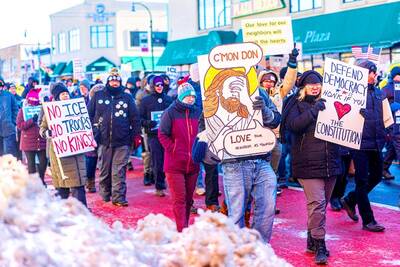When Los Angeles police officers unleashed a barrage of bullets early Monday into the car of a robbery suspect, killing him, five TV helicopters hovered above, beaming the scene into the homes of thousands of viewers.
Puffs of smoke could be seen as the officers fired their handguns into the car of Nicholas Killinger, 23, who toppled face down into the street in front of Santa Monica High School. Killinger, who was suspected of tying up a gas station attendant at knifepoint near Malibu and taking US$180 from his cash register, died an hour later.
While police pursuits are a staple of broadcast fare in freeway-laced Los Angeles and its environs, televised killings are not, and the latest shooting has revived a debate not only about what is proper to show on the local news but about how and when police should use their weapons in a chase.
Already under fire for its approach to using deadly force, the Los Angeles Police Department is struggling to revise a policy on pursuits and how to end them. Last June, Police Chief William Bratton ordered his officers to stop chasing drivers for traffic infractions or low-grade misdemeanors. In the six months that followed, the number of pursuits dropped 66 percent.
In the wake of the latest shooting, Bratton has reiterated his intent to review the deadly-force guidelines, which allow officers to shoot at vehicles that pose a threat. In the Killinger case, three officers appeared to react to the fact that the driver, who had been eluding law enforcement officers from various jurisdictions for more than an hour, stopped as he was trying a U-turn and then backed his white Ford Tempo into the front of a patrol car. The officers fired about 11 rounds.
It is not clear if the officers knew that Killinger was convicted last year for assault with a deadly weapon, although their knowledge of his suspected actions in the gas station earlier on Monday probably gave them sufficient reason to expect that he would be violent, said Geoffrey Alpert, a professor in criminology at the University of South Carolina.
"If a fleeing suspect has committed a crime that doesn't involve the use of violence, then a pursuit may not be justified because of the risk to the officers, the public and even the fleeing suspect," Alpert said in a telephone interview. "But if it's a carjacker or a rapist, it raises the level of risk that officers are allowed to take."
If the officers who fired at Killinger concluded that he was backing up his car "in a violent manner," Alpert said, that would be enough to justify firing at him in self-defense.
Los Angeles Police Department spokeswoman Kristi Sandoval said on Tuesday that Bratton and his staff were considering adopting some pursuit-ending procedures used by the California Highway Patrol, including laying spike strips on roads and bumping suspects' cars so that they spin out of control.
"We want to try to eliminate the pursuits being controlled by the suspect," Sandoval said, "so we can stop the pursuit on our terms."
Last year, there were 579 police pursuits -- 100 fewer than the previous year -- in Los Angeles, a city with a population of 3.8 million.
As the competition between local TV stations has become more intense, helicopters have given viewers a bird's-eye view of every conceivable event, with high-speed chases often the most dramatic. Since 1998, when a man was shown shooting himself on a highway overpass, some stations have tried to be more circumspect.
On Monday morning, as officers fired at Killinger, some of the airborne camera crews pulled back to a wide-angle view, to reduce the close-up detail on viewers' screens.
"You did not see him get shot on our air," Robert Long, news director of KNBC-TV, said in an interview. "It could have happened, but we have good people who know how to read these things."
Long said that he had directed his staff not to broadcast car chases unless there is "something extraordinary."
"It has to rise to the level of news, and not just something you can't take your eyes off of," he said.
Early last year, Bratton asked news directors informally to reduce or even halt their coverage of police pursuits, under the premise that they were treated as entertainment and that the broadcasts could encourage flight by suspects who want a moment in the spotlight. Many recall the day when, on the day he was supposed to turn himself in on murder charges, O.J. Simpson led police along the San Diego Freeway that was televised around the country.

Shamans in Peru on Monday gathered for an annual New Year’s ritual where they made predictions for the year to come, including illness for US President Donald Trump and the downfall of Venezuelan President Nicolas Maduro. “The United States should prepare itself because Donald Trump will fall seriously ill,” Juan de Dios Garcia proclaimed as he gathered with other shamans on a beach in southern Lima, dressed in traditional Andean ponchos and headdresses, and sprinkling flowers on the sand. The shamans carried large posters of world leaders, over which they crossed swords and burned incense, some of which they stomped on. In this

Indonesia yesterday began enforcing its newly ratified penal code, replacing a Dutch-era criminal law that had governed the country for more than 80 years and marking a major shift in its legal landscape. Since proclaiming independence in 1945, the Southeast Asian country had continued to operate under a colonial framework widely criticized as outdated and misaligned with Indonesia’s social values. Efforts to revise the code stalled for decades as lawmakers debated how to balance human rights, religious norms and local traditions in the world’s most populous Muslim-majority nation. The 345-page Indonesian Penal Code, known as the KUHP, was passed in 2022. It

‘TRUMP’S LONG GAME’: Minnesota Governor Tim Walz said that while fraud was a serious issue, the US president was politicizing it to defund programs for Minnesotans US President Donald Trump’s administration on Tuesday said it was auditing immigration cases involving US citizens of Somalian origin to detect fraud that could lead to denaturalization, or revocation of citizenship, while also announcing a freeze of childcare funds to Minnesota and demanding an audit of some daycare centers. “Under US law, if an individual procures citizenship on a fraudulent basis, that is grounds for denaturalization,” US Department of Homeland Security Assistant Secretary Tricia McLaughlin said in a statement. Denaturalization cases are rare and can take years. About 11 cases were pursued per year between 1990 and 2017, the Immigrant Legal Resource

ANGER: US-based activists reported protests at 174 locations across the country, with at least 582 arrested and 15 killed, while Khamenei said the protesters were ‘paid’ Iran’s supreme leader on Saturday said that “rioters must be put in their place” after a week of protests that have shaken the Islamic Republic, likely giving security forces a green light to aggressively put down the demonstrations. The first comments by 86-year-old Ayatollah Ali Khamenei come as violence surrounding the demonstrations sparked by Iran’s ailing economy has killed at least 15 people, according to human rights activists. The protests show no sign of stopping and follow US President Donald Trump warning Iran on Friday that if Tehran “violently kills peaceful protesters,” the US “will come to their rescue.” While it remains